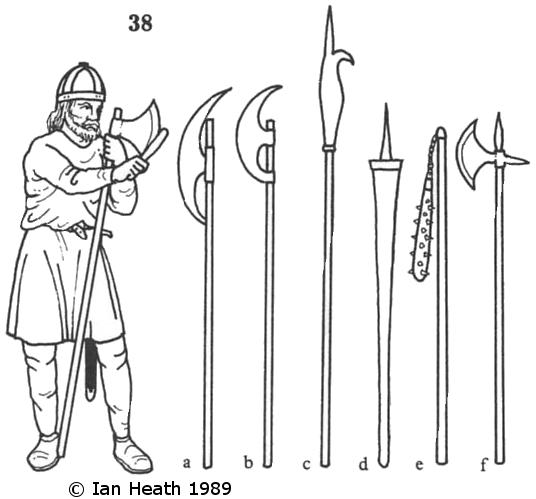
Join Amazon Prime - Watch Thousands of Movies & TV Shows Anytime - Start Free Trial Now
STAFF-WEAPONS, 12th-13th CENTURIES
An extract from Armies of Feudal Europe 1066-1300by Ian Heath



38. STAFF-WEAPONS, 12th-13th CENTURIES
Having just described armed peasants it is probably wise to add a note here regarding a range of weapons, initially based on agricultural implements, which evolved in a very short time into infantry staff-weapons of singular ferocity and considerable sophistication. By the 13th century such long-handled weapons as those shown here were known by a wide range of names including godendac, croc, faus, fauchard, glaive, pikte, gisarme, voulge, bill, halberd, etc, though it is never especially clear which term applies to what, for in those instances where they are described the details given are often so similar as to be virtually, if not completely, indistinguishable. It would appear, however, that many had a common ancestry, consisting basically of a long, broad cutting blade, usually with one or more points or hooks at the top or back.
The gisarme (also called a giseme or gaesa) appears in English and French sources from the 12th century onwards, occasionally being mentioned in use even as late as the 17th century. It was basically a type of axe with an elongated, crescent-shaped blade of which the lower point (or sometimes both) was usually secured to the haft by a second socket. It is sometimes described simply as an axe, while one 12th century source defines has a weapon 'which is called a bill'. 38a and b show gisarmes from French sources of the late-13th and early-14th centuries. With a spike at the back the gisarme appears to have been known as a voulge, a term which also appears in French sources from the 12th century. The Polish berdische was basically a gisarme.
The bill also appeared in the 12th century consisting basically of a pruning tool fixed to a long shaft. 38c depicts a bill from the now perished frescoes once in the Painted Chamber at Westminster. The bill seems to have always been a predominantly English weapon. The croc too was probably a kind of bill.
The fauchard appears only from the 12th century to the late-14th, mainly in French and occasionally in English sources. Contemporary descriptions indicate that had a scythe-like blade with a point at the top and another point or hook at the back. The faus (literally 'scythe') and faussal are clearly related, perhaps being smaller or short-handled versions of the same weapon. The unusual cleaver wielded by figure 28 is probably a faus or faussal.
The godendac or godendag, literally 'good morning', occurs in Flemish and, less often, French sources in the late-13th and early-14th centuries. Much ink has been wasted in arguments over whether or not the shafted and spiked club depicted in 38d (based on the Courtrai chest and Leugemeete fresco - see note 43) represents such a weapon, but the contemporary data seems quite conclusive that the godendac had cutting edge as well as a spear point. 38d in fact represents an entirely different weapon, the plançon-á-picot or chandelier. There is evidence to indicate that the godendac itself in fact evolved from a plough-share, Guiart describing it as a coulter or plough-share attached to a staff.
38e is a flaellum, the military version of the agricultural flail carried by figure 36. As can be seen, a spiked club has replaced the hinged limb of the latter. Others substituted a spiked wooden or metal ball attached to the staff by a short length of chain. Much shorter-handled versions, the 'ball and chain' beloved by Hollywood film producers, were in use among horsemen by the end of the 13th century but did not see much service.
The main figure is a Scandinavian of 13th century date armed with a very long-handled axe, possibly the weapon to which 14th century Icelandic saga writers applied the term 'halberd'. This word first appears, in a poem dating to before 1287, as hallembart; it also occurs as halmbarde, both words meaning haft-axe' or 'pole-axe'. 38f depicts an alternative axe type which frequently appears in 13th century illustrations.